Python Full Stack Training in Hyderabad
with
100% Placement Assistance
- Online |
- Class Room |
- 4 Months |
- Access Batches for Free Until Placement
Table of Contents
TogglePython Full Stack Training in Hyderabad
Batch Details
| Trainers Name | Tabassum |
| Trainers Experience | 10+ Years |
| Next Batch Date | 12 MAY 2025(Offline) 9:30AM To 10:30AM (IST) 12 MAY 2025(Online) 9:30AM To 10:30AM (IST) |
| Training Modes | Online and Offline Training (Instructor Led) |
| Course Duration | 4 months (Offline & Online) |
| Call us at | +91 9704944488 |
| Email Us at | pythonfullstackmasters.in@gmail.com |
Python Full Stack Training in Hyderabad
Why choose us?
- Real-world experience through phython projects
- Unrestricted access to content
- Achieve 1-2 years' expertise in just 4 months
- Certified expert trainers
- start from foundation-level phyton training
- 100% job oriented program
- Individualized mentorship with full project support
- 365 days of unlimited access to batches
- Latest skills and advanced topics
- Ongoing support until you secure a job
- Soft Skills Classes
- Recognized certification
- Resume writing and profile marketing strategies
- HR team facilitates job placement opportunities
Full Stack Python Developer Course In Hyderabad
Course Curriculum
HTML
Module 1- Introduction
- Basics of html and document structure
- Doctypes
- Basic Tags
- html
- head
- body
- title
- meta
- link
- script
Module 2 - Page Formatting
- Paragraphs
- Line breaks
- Blank space
- Pre Formatting text
- Headings
- Comments
Module 3-HTML Elements
- Element Types
- Block Elements
- Inline Elements
- Div
- Span
- Header
- Footer
- Section
- Article
- Nav
- Aside
Module 4 - Lists
- Un Ordered Lists
- ordered Lists
- Nested Lists
- Definition Lists
Module 5- Links in HTML
- What are links
- Text links
- Image links
- Opening link in new window / new tab
- Opening link in same same tab
- Links to content of same page
- Linking to an email
- Linking to a file
Module 6- Images
- Introduction to images
- Adding an image to web page
- Image alt text
- Image labels
Module 7-Tables
- Displaying data in table
- Table Header
- Table Body
- Table
- Thead
- Tbody
- Tr
- Td
- Th
- Row span
- Col span
Module 8 -Forms
- Introduction
- Text Box
- text
- password
- number
- date
- range
- url
- color
- Radio Button
- Check Boxes
- Select Box
- Multiple Select Box
- Text Area
- Submit Button
- Reset Button
Module 9 -Storage
- Web Storage
- Local storage
- Session storage
Module 10 - HTML Media
- introduction
- Audio
- Vedio
- Accessing audio/video from external source file in webpage
Module 11 - HTML Graphics
- Introduction to SVG and Canvas
- Creating line , circle , rectangle and polygon etc using svg / canvas
CSS 3 :
Module 12- Introduction
- Version history
- Css syntax
- Styling using external style sheets
- Styling using internal styles sheets
- Inline Styles
- Multiple stylesheets
Module 13 - Selectors
- Specificity
- Tag selector
- ID Selectors
- Class Selectors
- Grouping Selectors
- Universal Selector
- Descendant / Child Selectors
- Attribute Selectors
- CSS – Pseudo Classes
Module 14 - Text Fonts
- color
- background-color
- text-decoration
- text-align
- vertical-align
- text-indent
- text-transform
- white space
- letter-spacing
- word-spacing
- line-height
- font-family
- font-size
- font-style
- font-variant
- font-weight
Module 15 - Background
- Background Image
- Background color
- Background Position
- background repeat
Module 16 - Border
- order width
- Border Type
- Border Color
- Border radius
Module 17 - Box Model
- Margin
- Padding
- Width
- Height
- Borders
- Outline
Module 18 - Positioning
- Static
- Fixed
- relative
- Absolute
- Z-index
Module 19 - Display
- nline
- Inline Block
- block
- Table
- Flex
- Grid
- NONE
Module 20 - Visibility
- Visible
- Hidden
Module 21 - Responsive Web Design:
- Media Queries
- Breaking Points
- Targeting Web Page
- Targeting PDF
Module 22 - Transforms
- 2D Transforms
- 3D Transforms
- Transitions
- Animations
- CSS Short Hand
- Box Shadow
- Gradient
- Flex Box
- HTML Graphics
Module 23: React JS Installation
- Introduction to React JS
- Setting up the development environment
- Installing React using npm or yarn
- Creating a new React app with Create React App (CRA)
- Running the development server
Module 24: Basics
- Understanding React and its core concepts
- Virtual DOM vs Real DOM
- Components in React
- Rendering elements
- Importance of single-page applications (SPAs)
Module 25: JSX
- Introduction to JSX (JavaScript XML)
- Writing HTML-like syntax in JavaScript
- Embedding expressions in JSX
- JSX attributes and styling
- JSX vs plain JavaScript
Module 26: Class Components & Functional Components
- Understanding components in React
- Class components: structure and usage
- Functional components: modern approach
- Differences between class and functional components
- When to use each type
Module 27: Component Props
- What are props (properties)?
- Passing data between components
- Accessing props in class and functional components
- Default props
- Props vs state
Module 28: Component State
- Introduction to component state
- Setting and updating state
- Using state in class components (this.state)
- Using React hooks (useState) in functional components
- State vs props
Module 29: Hooks
- For
- For in
- While
- Do While
- For of
Module 30: Communication between components.
- For
- For in
- While
- Do While
- For of
Module 31: Reusable Components
- For
- For in
- While
- Do While
- For of
Module 32: Working with API data using fetch / axios library
- For
- For in
- While
- Do While
- For of
Module 33: Integrating Prime React UI Component library.
- For
- For in
- While
- Do While
- For of
Module 34: React Router
- Creating Routes and Router Layouts
- Navigation from JSX and React components
- Child Routes
- Reading Router Params
- Routing Context
- Authentication for routes.
Module 35: React Forms
- Creating Forms using vanilla react
- Creating forms using formic library.
Module 36: Redux
- Store
- Actions
- Dispatchers
- Reducers
- Immutability
- State management using redux library.
Module 37: Redux vs Flux
- Store
- Actions
- Dispatchers
- Reducers
- Immutability
- State management using the redux library.
Module 38: Unit Testing
- Understanding testing
- Introduction to Jest
- Test Running using Jest
- Mocking functions and modules
- Testing Components
- Snapshot Testing
- Async / Await.
PYTHON
Module 39: Introduction to Python
- What is Python?
- Why Python? Features & Applications
- Installing Python & Setting Up Environment (VS Code, Jupyter Notebook)
- Running Python Scripts (CMD & IDEs)
Module 40: Basic Python Concepts
- Variables and Data Types
- Operators in Python (Arithmetic, Logical, Bitwise, etc.)
- Type Conversion and Casting
- Input and Output Functions
Module 41: Control Flow Statements
Conditional Statements (if, elif, else)
- Looping Statements (for, while)
- Loop Control Statements (break, continue, pass)
Module 42: Data Structures in Python
- Lists
- Tuples
- Dictionaries
- Sets
Module 43: Functions & Modules
- Defining and Calling Functions
- Function Arguments (Default, Keyword, Arbitrary Arguments)
- Lambda Functions
- Built-in Functions
- Importing and Creating Modules
Module 44: Working with Strings
- String Operations
- String Slicing
- String Methods
- Regular Expressions (re module)
Module 45: File Handling
- Reading and Writing Files
- Working with CSV Files
- Exception Handling in File Operations
Module 46: Exception Handling
- Understanding Exceptions
- Try, Except, Finally Blocks
- Raising Exceptions
Module 47: Object-Oriented Programming (OOPs)
- Classes and Objects
- Constructors (init method)
- Inheritance (Single, Multiple, Multilevel, Hybrid)
- Polymorphism & Method Overriding
- Encapsulation & Data Hiding
Module 48: Advanced Python Concepts
- List Comprehensions
- Generators & Iterators
MYSQL
Module 49: Introduction to MySQL
- What is MySQL?
- Features of MySQL
- Installing MySQL (Windows, Linux)
- MySQL Workbench & Command Line Interface
- Understanding Databases and Tables
Module 50: MySQL Basics
- SQL vs MySQL
- Data Types in MySQL
- Creating a Database (CREATE DATABASE)
- Selecting a Database (USE DATABASE)
• Deleting a Database (DROP DATABASE)
Module 51: Working with Tables
- Creating Tables (CREATE TABLE)
- Column Constraints (NOT NULL, UNIQUE, DEFAULT, CHECK)
- Primary Key & Foreign Key
- Altering Tables (ALTER TABLE)
- Deleting Tables (DROP TABLE)
Module 52: CRUD Operations
- INSERT Data (INSERT INTO)
- READ/SELECT Data (SELECT FROM)
- UPDATE Data (UPDATE SET WHERE)
- DELETE Data (DELETE FROM WHERE)
Module 53: Aggregate Functions & Grouping Data
- COUNT, SUM, AVG, MIN, MAX Functions
- Grouping with GROUP BY
• Filtering Groups with HAVING
Module 54: MySQL Joins
- INNER JOIN
- LEFT JOIN (LEFT OUTER JOIN)
- RIGHT JOIN (RIGHT OUTER JOIN)
- FULL JOIN (FULL OUTER JOIN)
- Self Join
- Cross Join
Module 55: Subqueries & Nested Queries
- What is a Subquery?
- Single Row Subqueries
- Multiple Row Subqueries
- Correlated Subqueries
- Using EXISTS and NOT EXISTS
Module 56: Views and Indexing
- Creating Views (CREATE VIEW)
- Updating & Deleting Views (UPDATE, DROP VIEW)
- What is Indexing?
- Creating Indexes (CREATE INDEX)
- Types of Indexes (Primary, Unique, Full-text)
Module 57: Stored Procedures & Functions
- What is a Stored Procedure?
- Creating a Stored Procedure (CREATE PROCEDURE)
- Calling a Stored Procedure (CALL)
- MySQL Functions (CREATE FUNCTION)
- Differences Between Procedures & Functions
Module 58: Triggers & Events
- What are Triggers?
- Creating Triggers (BEFORE INSERT, AFTER INSERT, BEFORE UPDATE, AFTER UPDATE)
- Deleting Triggers
- MySQL Events & Scheduling Tasks
Module 59: MySQL Transactions
- Understanding Transactions
- Using COMMIT & ROLLBACK
- Savepoints in Transactions (SAVEPOINT, ROLLBACK TO SAVEPOINT)
Module 60: Window functions
- Window functions
- Types of window functions
- Numeric functions
- Rank functions
Django
Module 61: Setting your development environment:
- Installing Django
- Starting a Django project
- Running the Django server
- Exploring the project files
Module 62: Creating your first Django project:
- Creating a Django app
- Adding a page
- When it doesn’t work
- Django and the flow of control
- Adding an about page
Module 63: Django’s MVT architecture:
- Introducing templates and the MVT pattern
- A template for the welcome page
- Template variables and dynamic content
- Completing the MVT pattern
- Taking a parameter from the URL
- Returning a 404 error
Module 64: Data models
- Create read updates and delete records
- Define relationships between data
- Validate data before saving
- Query database using ORM
- Introducing models and migrations
- Running initial migrations
- Creating model class
- Creating and running migrations
- The admin interface
Module 65: Views
- Http requests (get, post, put delete, options.)
- Processing data from models
- Handle user inputs
- Form validation
- Returning appropriate https responses(html, Json, Redirects )
Module 66: Templates
- Introduction to DTL(django template language)
- Inserting data dynamically into HTML
- Template inheritance
- Filters
- Tags
- Adding styling with CSS
- Adding an image
Module 67: Django forms
- A template with a modelform
- Submitting the form
- Processing user input
- Understanding the program flow for processing a form
- Validation and security
Module 68: URL Routing
- Url configuration
- Url pattern matching
- Path converters
- Naming URL patterns
- Url name spaces
- Class based views
- List and detailed views
- Debugging url configurations
Module 69: Admin interface
- Basic setup
- Custom model admin class
- Field sets for forms
- In line editing for models
- Custom display methods with formatting
- Custom filtering ad search
Module 70: Authentication
- Basic setup
- Configuring authentication middleware
- Registration template
- Login and logout
- Password reset
- Protecting views
- User context
Module 71: Project
- Implementing conference application
- Creating a meeting
- Editing a meeting
- Deleting a meeting
- Display all meeting using grids and charts
- Enabling authentication for users
- Implementing top level common templates
- Configuring login and logout views
- Reacting to user login status
- Restricting access to views
- Customizing the admin interface
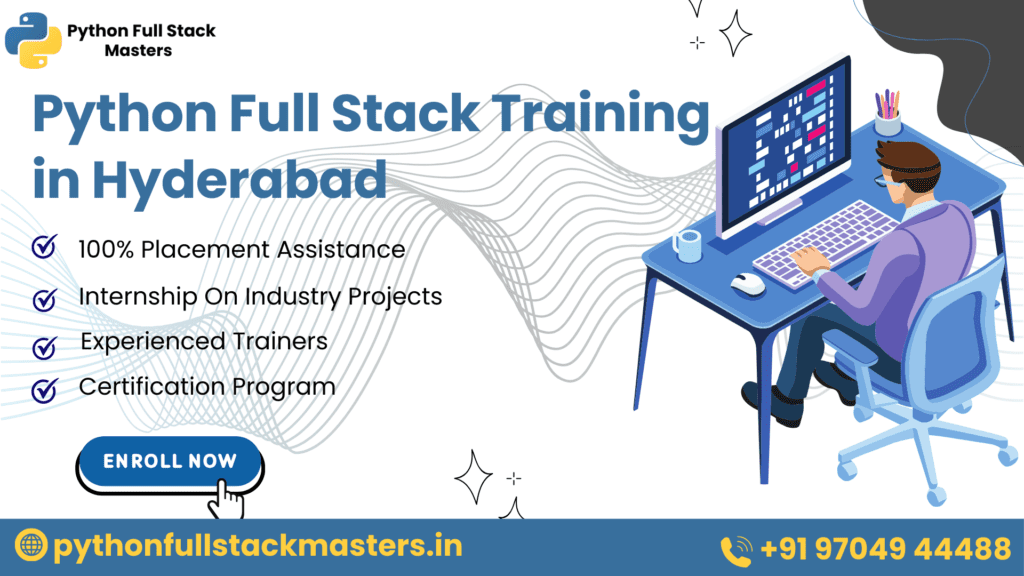
Best Python Full Stack Developer Course in Hyderabad
- The Advanced Python Full Stack Training Course is designed for both beginners and experts.
- The trainers are experts in the field, with more than 15 years of experience.
- In the last 3 months, our academy has taught over 200 students and helped more than 80 get jobs.
- Gain Knowledge in client-side and server-side Python applications with practical, hands-on learning.
- Learn to use Python's powerful tools for managing browsers, servers, and databases.
- Learn how to use MongoDB to build apps, test software, release them, and manage data.
- Python Full StackTraining is in high demand because it enables developers to build full web applications with Python for both the front-end and back-end, meeting the industry's need for skilled and efficient professionals.
- A syllabus created by experts for a Python Full Stack web developer course, ready for the industry.
- Explore advanced concepts of the Python Full Stack Developer course through hands-on labs and real-time training.
- Get free access to live class recordings available right away (for online batches only).
- All participants will receive full 100% placement support.
- Get personal attention and guidance to speed up your learning.
- Python is great for full-stack development because it is flexible, has a strong ecosystem, and includes frameworks like Django and Flask for a powerful backend, along with popular front-end libraries like React or Vue.js.
- Python full-stack development is easy to start with due to Python's simple readability, but becoming fully skilled in both front-end and back-end technologies can be challenging.
- At our academy, anyone can learn full-stack Python development, even without an IT background, and gain skills in both front-end and back-end technologies for web development.
- Python 3 is recommended for full-stack development because it offers the latest features, ongoing support, and compatibility with modern web development frameworks.
Python Fullstack Training In Hyderabad
Modes of Training
Online Training
- Lifetime Video Access
- Certification-oriented
- Affordable course fee
- Basic to advance level
- Including live project
- 100% Placement Assistance
- Interview Guidance
- Whatsapp Group Access
Offline Training
- In-Person Classes
- Comprehensive Curriculum
- Mentorship Programs
- Assistance till Placed
- Certification training dumps
- Course Materials
- Project based learning
- Interview Guidance
Corporate Training
- Live Project Training
- Advance Level Course
- Company-specific batch
- Flexible class timing
- Doubt-clearing sessions.
- Video Materials Access
- Certification Dumps
- Whatsapp Group Access
Python Full Stack Training in Hyderabad
Tools Covered
- Frontend:
- HTML/CSS: Design web pages.
- JavaScript: Add interactivity.
- Frameworks: Tools like React or Angular for advanced interfaces.
- Backend:
- Python: Server-side programming.
- Django/Flask: Simplify backend development.
- Databases:
- SQL: For structured data.
- NoSQL: For flexible data.
- APIs: Connect front and back ends (REST/GraphQL).
- Version Control: Git/GitHub for tracking changes.
- Deployment: Docker, Heroku, or AWS for hosting.
- Tools: VS Code, Postman, and testing frameworks.

What Is Python Full Stack Development?
- Python Full Stack Development refers to the ability to work on both the front-end (user interface) and back-end (server, database) of a web application Full stack developing using python
- A full-stack developer has the skills to handle all aspects of application development, ensuring seamless integration between the user-facing elements and server-side functionalities.
- Python Full Stack is a development approach where Python is used for both the front-end (user interface) and back-end (server-side logic) of a web application.
- It involves using Python frameworks and libraries to handle everything from designing the user interface to managing the server-side operations and database.
- Python Full Stack Masters Training is a course that teaches you how to build complete web applications, covering both the front-end (user interface) and back-end (server-side).
It typically includes:
- Learn Python programming for back-end development.
- Build front-end with HTML, CSS, and JavaScript.
- Use frameworks like Django or Flask.
- Manage data with databases (SQL or NoSQL).
- Deploy applications to platforms like AWS or Heroku.
- Work on real projects for hands-on experience.
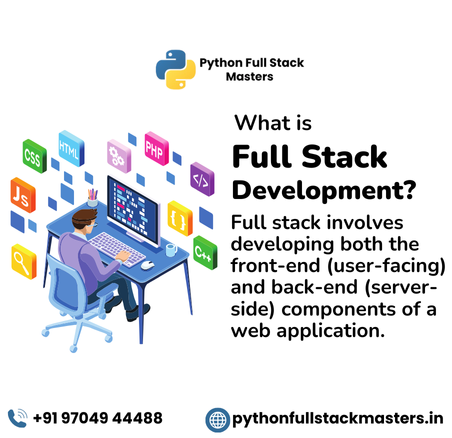
Python Full Stack Developer Course in Hyderabad
Learning Objectives
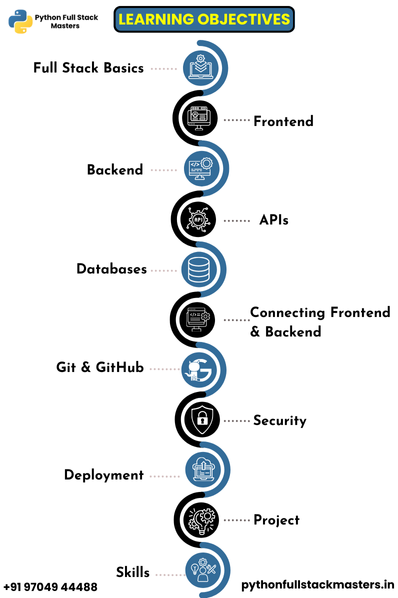
- Full Stack Basics
Learn front end (UI) and back end (server-side) development. - Frontend
- HTML, CSS, JavaScript
- React/Angular, Git, Build Tools
- Backend
- Python, Flask/Django
- Databases, secure logins
- APIs
- REST, GraphQL
- Databases
- SQL (MySQL), NoSQL (MongoDB)
- Connecting Frontend & Backend
- AJAX, State Management
- Git & GitHub
- Code management and collaboration
- Security
- Protect app, encrypt data, secure APIs
- Deployment
- Cloud hosting, Docker, automated deployments
- Project
- Build, deploy, troubleshoot web app
- Skills
- Problem-solving, teamwork
Python Full Stack Training Learning
Pre-Requisites
- Basic Programming Skills Learn concepts like variables, loops, conditions, and functions.
- Python Basics Master Python syntax, functions, and object-oriented programming (OOP).
- Basic Web Development Understand HTML, CSS, and JavaScript for web pages.
- Database Basics Learn SQL, create, and manage databases.
- Version Control (Git) Use Git and GitHub for code management and collaboration.

Who Should Enroll in Python Full Stack Training in Hyderabad?
Aspiring Web Developers
If you want to create both the front-end (what users see) and back-end (server side) of websites, Python is a good choice to learn.
Software Engineers
Developers who want to add full-stack skills to their resume can benefit from this course.
Backend Developers
If you already work with Python on the back end, learning full-stack can help you understand the front end and make you more flexible.
Students and Graduates
If you’re studying computer science or have basic programming knowledge, full-stack training can open up more job opportunities.
Entrepreneurs and Freelancers
If you want to build your web apps or start a business, full-stack skills help you work on all parts of the project yourself.
Data Scientists
If you’re a data scientist, full-stack training can help you build websites to showcase your data and models.
Developers Looking for Growth
If you’re already experienced in one area of web development, learning full-stack will help you grow in your career.
Outline of Python Full Stack Training in Hyderabad
01
Python Fundamentals
Master Python basics like syntax, data types, loops, functions, and object-oriented programming (OOP).
02
Git & Version Control
Learn Git for tracking changes, collaborating on code, and managing project versions.
03
Web Development Essentials
Understand the core concepts of HTML, CSS, and JavaScript for building simple web pages.
04
Introduction to Django/Flask
Explore Django or Flask frameworks for developing server-side applications.
05
Database Fundamentals
Get hands-on with relational databases like MySQL or PostgreSQL and learn how to perform CRUD operations using SQL.
06
Working with Django/Flask ORM
Learn how to interact with databases seamlessly using Django ORM or SQLAlchemy (Flask).
07
Frontend Development
Gain skills in JavaScript frameworks like React or Vue.js to create dynamic, responsive user interfaces.
08
API Development
Learn how to build RESTful APIs using Django REST Framework or Flask to enable communication between front-end and back-end.
09
Authentication & Security
Grasp the concepts of user authentication and authorization to secure web applications.
10
Web App Deployment
Learn to deploy applications on cloud services such as Heroku, AWS, or DigitalOcean.
11
Advanced JavaScript & Node.js
Deepen your JavaScript knowledge and learn server-side development using Node.js, Express.js, and connecting to databases.
12
Testing & Debugging
Learn how to write unit tests, perform debugging, and ensure the reliability of your applications.
Overview Of Python Full Stack Training in Hyderabad
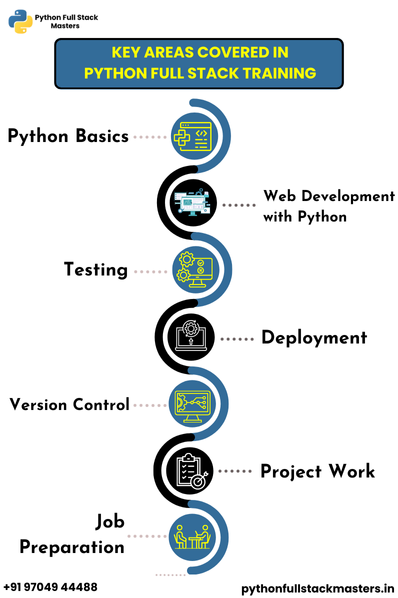
- Python Basics: Learn core concepts, data types, functions, and OOP.
- Web Development:
- Back-End: Build server-side apps using Django or Flask.
- Front-End: Use HTML, CSS, JavaScript, and frameworks like React or Angular.
- Connect front-end and back-end with APIs.
- Version Control: Master Git and GitHub for collaboration.
- Deployment: Deploy apps with Heroku, AWS, and manage with Docker.
- Testing: Debug and test with Python testing tools.
- Project Work:
- Develop real-world projects (e-commerce, social media).
- Complete a capstone project to showcase skills.
- Job Preparation:
- Resume building, interview tips, and job placement support.
- Create a project portfolio for employers.
- Python Questions For Practice
Python Full Stack Course in Hyderabad
Career Opportunities
01
Full Stack Developer
- What They Do: Full Stack Developers create both the front-end and back-end of web applications. They use Python, HTML, CSS, JavaScript, and frameworks like Django or Flask for the back end, and React or Angular for the front end.
- Skills Needed: Knowledge of both front-end and back-end technologies, working with databases, APIs, and version control systems.
02
Back-End Developer
- What They Do: Back-end developers focus on the server side of web applications. They manage databases and handle the logic behind how the application works, using Python frameworks like Django or Flask.
- Skills Needed: Proficiency in Python, databases (SQL or NoSQL), and APIs.
03
Front-End Developer
- What They Do: While more focused on what users see (the website or app’s design and interaction), front-end developers benefit from knowing Python for connecting the front-end to back-end systems.
- Skills Needed: HTML, CSS, JavaScript, and the ability to connect the front-end with back-end technologies.
04
Software Engineer
- What They Do: Software Engineers develop applications using various technologies, including Python. They can work on specific parts of a system or across the entire stack.
- Skills Needed: Strong programming skills, problem-solving, and understanding of both front-end and back-end systems.
05
DevOps Engineer
- What They Do: DevOps Engineers manage the infrastructure that supports web applications, ensuring everything runs smoothly. They use Python for automating tasks and work with tools like Docker and cloud services.
- Skills Needed: Knowledge of cloud platforms (AWS, Azure), Python for automation, and DevOps tools.
06
Database Administrator (DBA)
- What They Do: DBAs manage the databases that store data for web applications. Python knowledge helps them manage and integrate databases with back-end systems.
- Skills Needed: Expertise in SQL/NoSQL databases, database optimization, and Python scripting.
07
Web Application Developer
- What They Do: These developers create web applications using both front-end and back-end technologies. Python is used for the back-end while HTML, CSS, and JavaScript handle the front-end.
- Skills Needed: Full stack development knowledge and an understanding of web technologies.
08
Freelance Developer or Entrepreneur
- What They Do: As a freelance developer, you can work with different clients, building custom web applications. If you’re entrepreneurial, you can even start your own tech business.
- Skills Needed: Strong self-management, business skills, and proficiency in both front-end and back-end development.
09
Technology Consultant
- What They Do: Consultants advise businesses on improving their technology systems. With a Full-stack background, you can suggest solutions for both the front-end and back-end of an application.
- Skills Needed: Broad knowledge of tech stacks, problem-solving skills, and the ability to tailor solutions for clients.
10
UX/UI Designer with Tech Skills
- What They Do: If you’re interested in design, you can combine UX/UI design skills with technical knowledge. This way, you can build beautiful, user-friendly apps while making sure they work smoothly with the back end.
- Skills Needed: Design skills, Python knowledge for integration, and a strong understanding of user experience.
Python Full Stack Web Developer Salary in Hyderabad
Career Growth & Salary Expectations
Entry-Level (0-2 years):
- Role:
- Learn and assist with tasks like coding, debugging, and small project work under the guidance of senior developers.
- Typically join as Junior Developers.
- Salary: ₹4,00,000 to ₹6,00,000 per year.
- Salary varies based on the company, location, and skill level.
- Tech hubs like Bengaluru, Hyderabad, and Pune often offer higher pay due to the high demand for developers.
Mid-Level (3-5 years):
- Role:
- Develop a strong understanding of both front-end and back-end technologies.
- Take on more responsibilities like leading smaller projects, collaborating with teams, and mentoring junior developers.
- Salary: ₹6,00,000 to ₹8,00,000 per year.
- Typically work as Full Stack or Backend Developers in mid-sized companies or startups.
- Salary increase reflects improved technical skills and leadership experience.
Senior-Level (5+ years):
- Role:
- Expected to have deep expertise in both front-end and back-end technologies.
- Take on roles like Technical Lead, Project Manager, or Engineering Manager.
- Responsible for designing complex systems, leading teams, and making high-level technical decisions.
- Salary: ₹8,00,000 to ₹12,00,000+ per year.
- Additional specialization in areas like DevOps, Cloud, or Machine Learning can increase salary potential.
- Senior developers often work in well-established companies or large tech firms.
Additional Salary Information:
- Freelancing/Entrepreneurship:
- Freelancers or entrepreneurs can earn much higher incomes, but earnings may not be as consistent.
- Successful freelancers can earn between ₹7,00,000 to ₹20,00,000+ per year, depending on the number of clients and projects.
Skill Developed Post Python Full Stack Training
01
Front-End Development:
- HTML/CSS: Build and style web pages.
- JavaScript: Add interactive features like buttons and dynamic content.
- React or Angular: Create smooth, interactive user interfaces with popular frameworks.
- Responsive Design: Ensure your website looks good on phones, tablets, and desktops.
- Version Control (Git): Track code changes and collaborate with others.
02
Back-End Development:
- Python: Use Python to manage the server-side logic.
- Django or Flask: Build web applications using these Python frameworks.
- REST APIs: Develop APIs to allow communication between the front-end and back-end.
- User Authentication: Implement secure login systems.
- Databases: Work with relational (MySQL, PostgreSQL) or NoSQL (MongoDB) databases.
- ORM (Object-Relational Mapping): Interact with databases using Python, without needing complex SQL queries.
03
Deployment and DevOps:
- Docker: Containerize your app for easy deployment across different environments.
- Cloud Hosting: Deploy your application on cloud platforms like AWS or Heroku.
- CI/CD Pipelines: Automate testing and deployment to ensure smooth updates.
Web Servers: Set up and manage web servers like Nginx to host your app.
04
Additional Skills:
- Testing: Write tests to ensure your code works correctly.
- Security: Implement measures to protect your app from online threats.
- Agile Development: Work efficiently with teams using agile methodologies.
- Problem Solving: Troubleshoot and optimize your app’s performance.
Python Full Stack Certification Training in Hyderabad
- Our Python Full Stack Training Course is designed to provide students with the skills necessary to write clean, efficient code for building high-quality applications.
- Organized with industry certification standards, the course prepares students to pass exams and secure top roles at leading companies.
- Upon completion, students will earn a certificate of completion, which is widely recognized by employers. You can choose to receive your certificate digitally or in a physical format.
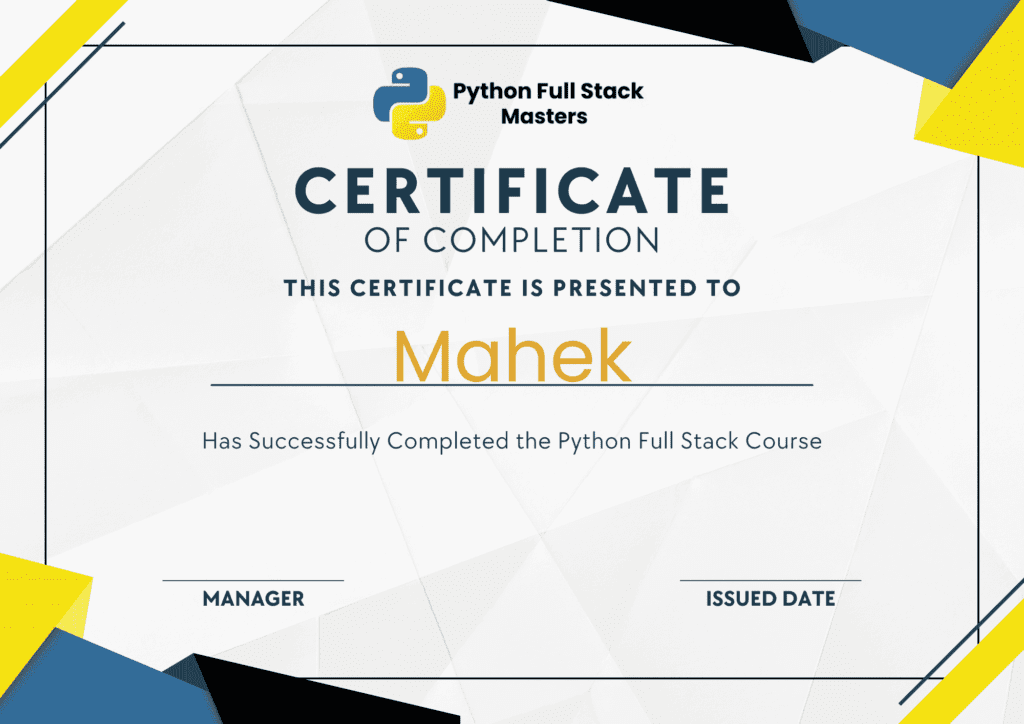
Python Full Stack Certifications
- Certified Data Scientist with Python (DataCamp)
- Django Certification
- Google IT Automation with Python (Coursera)
- OpenEDG Python Certifications
- Data Analytics Certifications (Pandas & NumPy)
- PCEP: Certified Entry-Level Python Programmer
- PCAP: Certified Associate in Python Programming
- PCPP: Certified Professional in Python Programming
- Microsoft Certified: Azure Data PCAP: Certified Associate in Python Programming
- Google Professional Data Engineer
- AWS Certified Machine Learning – Specialty
Our Python Full Stack Training Institute in Hyderabad
Testimonials
Priyanka K

@Priyanka
Enrolling in the Python Full Stack Training in Hyderabad at Python Full Stack Masters was the best decision I made for my career! The hands-on projects and expert guidance truly set this program apart as the best Python Full Stack course in Hyderabad.
Sneha

@sneha
I am incredibly grateful to Python Full Stack Masters for their Python Full Stack Developer Training in Hyderabad. The interactive sessions and real-world examples made mastering full-stack development straightforward and enjoyable. I highly recommend this program!”
Vijay C

@Vijay
The Full Stack Python Developer Program in Hyderabad at Python Full Stack Masters is perfectly designed for aspiring developers. The practical approach and in-depth curriculum prepared me to tackle real-world challenges confidently.
Ranjeet

@ranjeet
Python Full Stack Masters is my go-to recommendation for the Python and Django Full Stack Course in Hyderabad. The faculty’s expertise and the hands-on training made the entire learning experience outstanding.
Minakshi

@minakshi
The Full Stack Development Course with Python at Python Full Stack Masters in Hyderabad is perfect for beginners. The instructors make complex topics easy to understand with clear, actionable steps.
Vikram

@vikram
The Python Full Stack Training with Placement in Hyderabad was worth every penny! Python Full Stack Masters didn’t just teach me coding—they helped me build a successful career
Abhishek R

@abhishek
As a complete beginner, I was nervous about learning coding. But the Full Stack Python Course for Beginners in Hyderabad at Python Full Stack Masters made it so easy and enjoyable. I’d recommend it to anyone
Payel

@payel
The internship program at Python Full Stack Masters provided valuable industry exposure and helped me kickstart my career in Python Full Stack Development in Hyderabad. It was an exceptional learning experience
Raj

@raj
I opted for the Online Python Full Stack Training in Hyderabad at Python Full Stack Masters, and it was fantastic! The live sessions and recorded materials gave me the flexibility to learn at my own pace without compromising quality.
Our Python Full Stack Developer Course
Trainer
Tabassum
10+ Years of Experience
Tabassum is a friendly and skilled trainer who makes learning easy and enjoyable.
She is good at teaching both technical and personal skills and changes her way of teaching based on what her students need.
Tabassum’s sessions are interactive and practical, helping students use what they learn in real life. She creates a positive and open space where everyone feels comfortable to ask questions.
Tabassum keeps learning new things herself to make sure her lessons are up to date. She explains things clearly and helps students understand even the strong topics. She encourages students and helps them feel confident in their capability. Tabassum truly cares about her students and works hard to help them succeed.

Python Full Stack Developer Training
Benefits
Learn Both Frontend and Backend
Learn Full-Stack Web Development: Master both frontend (HTML, CSS, JavaScript, React) and backend (Flask, Django) skills, along with database management (SQL, PostgreSQL, MongoDB) to build robust, data-driven applications.
Increased Job Opportunities
Full-stack developers are in high demand because they can handle all parts of a project, making them valuable to employers.
Better for Employers
Companies prefer full-stack developers because they can do both frontend and backend work, saving them money and resources.
Faster Development
Knowing both frontend and backend helps you speed up the development process and find solutions more quickly.
Better Problem Solving
Understanding the whole process helps you solve problems and create smarter solutions.
Better Communication
Knowing both sides lets you work better with other team members, like designers and backend developers.
Growing Demand
Python is a popular language, so learning full-stack development with Python opens up more job opportunities.
Learn Through Practice
Most courses focus on hands-on projects, so you get real experience while learning.
Adaptable Skills
Full-stack developers can work with many different tools, making them flexible for various projects.
Python Full Stack Training
Market Trend
01
High Demand for Full Stack Developers
Companies are increasingly looking for developers skilled in both front-end (user interface) and back-end (server-side logic) development. Full Stack Developers are in high demand, with job openings for these roles growing by 20% annually.
02
Integration of AI and Machine Learning
Python is a key language for building intelligent applications with AI and machine learning. Developers proficient in Python can tap into this growing trend, with the AI and machine learning market expected to grow over 40% by 2027.
03
Cloud-Based Development
As more businesses transition to the cloud, Python’s compatibility with cloud platforms such as AWS and Google Cloud is making it a top choice for building scalable web applications. The global cloud computing market is predicted to grow at a 17% compound annual growth rate (CAGR) from 2023 to 2030.
04
Rise of Low-Code/No-Code Platforms
Low-code platforms allow easier app creation with minimal coding. Python developers leverage these platforms to automate tasks and streamline development processes. The global low-code development platform market is expected to grow by 28.1% CAGR from 2021 to 2028.
05
Focus on Cybersecurity
The increasing number of cyber threats has raised the need for developers who can build secure, privacy-compliant applications. The global cybersecurity market is expected to reach ₹32,45,000 crore by 2028. In India, cybersecurity-focused developers can expect to earn between ₹8,00,000 and ₹18,00,000 annually.
06
Better Salaries
With the high demand for Python Full Stack Developers, salaries have increased significantly. On average, a Python Full Stack Developer in India earns between ₹10,00,000 and ₹15,00,000 per year, with higher salaries in tech-centric regions such as Bangalore and Hyderabad.
Our Accomplishments
FAQ’S
A Stack Developer is a professional who works on both the front-end (client-side) and back-end (server-side) of web applications. They handle everything from designing the user interface (UI) to managing the database and server-side logic.
You’ll learn:
- Python for back-end development
- Front-end skills like HTML, CSS, JavaScript, and React.js
- How to work with databases like MySQL and MongoDB
- How to manage code with Git and deploy apps online
No, the course is beginner-friendly. You’ll start with the basics of Python and work your way up.
The course typically lasts between 3 to 6 months, depending on whether you choose a part-time or full-time schedule.
Yes, you’ll work on practical projects that simulate real-world applications. These projects are designed to help you build a strong portfolio, which is key to securing employment after completing the course.
Yes, full-stack developers are highly sought after for freelance work. With the skills gained in this course, you will be prepared to take on freelance web development projects.
Course fees vary, but they typically range from ₹40,000 to ₹4,00,000, depending on the provider, course duration, and additional services offered (e.g., mentorship, job placement assistance).
Full Stack Developers are in high demand across various industries, including tech, finance, and healthcare. Some job roles you can pursue include:
- Full Stack Developer
- Web Developer
- Back-end Developer
- Front-end Developer
- Python Developer
You’ll work with tools like:
- Python frameworks: Django, Flask
- Databases: MySQL, MongoDB
- Version control: Git
Front-end frameworks: React.js, Angular
You can enroll through the our website or by contacting our admissions team. Some courses may offer demo classes or a trial period before full enrollment.
Get in touch with us

